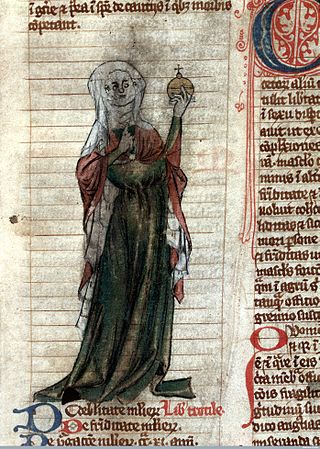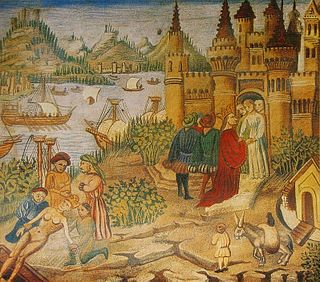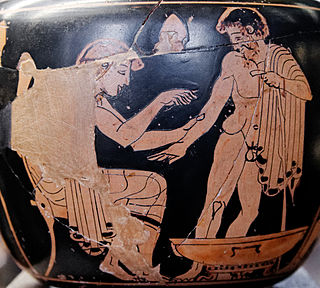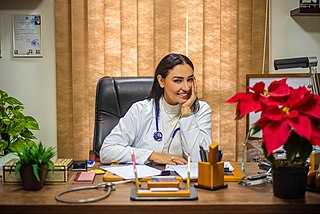Related Research Articles
Bartholomaeus Anglicus, also known as Bartholomew the Englishman and Berthelet, was an early 13th-century Scholastic of Paris, a member of the Franciscan order. He was the author of the compendium De proprietatibus rerum, dated c.1240, an early forerunner of the encyclopedia and a widely cited book in the Middle Ages. Bartholomew also held senior positions within the church and was appointed Bishop of Łuków in what is now Poland, although he was not consecrated to that position.

Medieval literature is a broad subject, encompassing essentially all written works available in Europe and beyond during the Middle Ages. The literature of this time was composed of religious writings as well as secular works. Just as in modern literature, it is a complex and rich field of study, from the utterly sacred to the exuberantly profane, touching all points in-between. Works of literature are often grouped by place of origin, language, and genre.

Trotula is a name referring to a group of three texts on women's medicine that were composed in the southern Italian port town of Salerno in the 12th century. The name derives from a historic female figure, Trota of Salerno, a physician and medical writer who was associated with one of the three texts. However, "Trotula" came to be understood as a real person in the Middle Ages and because the so-called Trotula texts circulated widely throughout medieval Europe, from Spain to Poland, and Sicily to Ireland, "Trotula" has historic importance in "her" own right.

In the Middle Ages, the medicine of Western Europe was composed of a mixture of existing ideas from antiquity. In the Early Middle Ages, following the fall of the Western Roman Empire, standard medical knowledge was based chiefly upon surviving Greek and Roman texts, preserved in monasteries and elsewhere. Medieval medicine is widely misunderstood, thought of as a uniform attitude composed of placing hopes in the church and God to heal all sicknesses, while sickness itself exists as a product of destiny, sin, and astral influences as physical causes. On the other hand, medieval medicine, especially in the second half of the medieval period, became a formal body of theoretical knowledge and was institutionalized in the universities. Medieval medicine attributed illnesses, and disease, not to sinful behaviour, but to natural causes, and sin was connected to illness only in a more general sense of the view that disease manifested in humanity as a result of its fallen state from God. Medieval medicine also recognized that illnesses spread from person to person, that certain lifestyles may cause ill health, and some people have a greater predisposition towards bad health than others.

The Schola Medica Salernitana was a medieval medical school, the first and most important of its kind. Situated on the Tyrrhenian Sea in the south Italian city of Salerno, it was founded in the 9th century and rose to prominence in the 10th century, becoming the most important source of medical knowledge in Western Europe at the time.

Rebecca Lee Crumpler, born Rebecca Davis,, was an American physician, nurse and author. After studying at the New England Female Medical College, in 1864 she became the first African American woman to become a doctor of medicine in the United States. Crumpler was also one of the first female physician authors in the nineteenth century. In 1883, she published A Book of Medical Discourses. The book has two parts that cover the prevention and cure of infantile bowel complaints, and the life and growth of human beings. Dedicated to nurses and mothers, it focuses on maternal and pediatric medical care and was among the first publications written by an African American on the subject of medicine.

Ancient Greek medicine was a compilation of theories and practices that were constantly expanding through new ideologies and trials. The Greek term for medicine was iatrikē. Many components were considered in ancient Greek medicine, intertwining the spiritual with the physical. Specifically, the ancient Greeks believed health was affected by the humors, geographic location, social class, diet, trauma, beliefs, and mindset. Early on the ancient Greeks believed that illnesses were "divine punishments" and that healing was a "gift from the Gods". As trials continued wherein theories were tested against symptoms and results, the pure spiritual beliefs regarding "punishments" and "gifts" were replaced with a foundation based in the physical, i.e., cause and effect.

Dorotea Bocchi (1360–1436) was an Italian noblewoman known for studying medicine and philosophy. Dorotea was associated with the University of Bologna, though there are differing beliefs regarding the extent of her participation at the university ranging, from whether she taught or held a position there. Despite these debates, there is consensus that she flourished and was active at the university for more than 40 years, beginning from 1390 onwards.
Abella, often known as Abella of Salerno or Abella of Castellomata, was a physician in the mid fourteenth century. Abella studied and taught at the Salerno School of Medicine. Abella is believed to have been born around 1380, but the exact time of her birth and death is unclear. Abella lectured on standard medical practices, bile, and women's health and nature at the medical school in Salerno. Abella, along with Rebecca de Guarna, specialized in the area of embryology. She published two treatises: De atrabile and De natura seminis humani, neither of which survive today. In Salvatore De Renzi's nineteenth-century study of the Salerno School of Medicine, Abella is one of four women mentioned who were known to practice medicine, lecture on medicine, and wrote treatises. These attributes placed Abella into a group of women known as the Mulieres Salernitanae, or women of Salerno.

The presence of women in medicine, particularly in the practicing fields of surgery and as physicians, has been traced to the earliest of history. Women have historically had lower participation levels in medical fields compared to men with occupancy rates varying by race, socioeconomic status, and geography.
Constance Calenda was an Italian surgeon specializing in diseases of the eye. She studied at the University of Salerno, and was one of the women known as the "ladies of Salerno".
Gilles de Corbeil was a French royal physician, teacher, and poet. He was born in approximately 1140 in Corbeil and died in the first quarter of the 13th century. He is the author of four medical poems and a scathing anti-clerical satire, all in Latin dactylic hexameters.
Mercuriade (14th-century) was an Italian physician, surgeon and medical author. She is one of the few woman physicians known from the Middle Ages.
Jacqueline Felice de Almania, was reportedly from Florence, Italy. She was an early 14th-century French physician in Paris, France who was placed on trial in 1322 for unlawful practice.
Midwifery in the Middle Ages impacted women's work and health prior to the professionalization of medicine. During the Middle Ages in Western Europe, people relied on the medical knowledge of Roman and Greek philosophers, specifically Galen, Hippocrates, and Aristotle. These medical philosophers focused primarily on the health of men, and women's health issues were understudied. Thus, these philosophers did not focus on the baby and they encouraged women to handle women's issues. In fact, William L. Minkowski asserted that a male's reputation was negatively affected if he associated with or treated pregnant patients. Resultantly, male physicians did not engage with pregnant patients, and women had a place in medicine as midwives. Myriam Greilsammer notes that an additional opposition to men's involvement in childbearing was that men should not associate with female genitalia throughout the secret practices of childbearing. The prevalence of this mindset allowed women to continue the practice of midwifery throughout most of the Medieval era with little or no male influence on their affairs. Minkowski writes that in Guy de Chauliac's fourteenth-century work Chirurgia magna, "he wrote that he was unwilling to discourse on midwifery because the field was dominated by women." However, changing views of medicine caused the women's role as midwife to be pushed aside as the professionalization of medical practitioners began to go up.

Trota of Salerno was a medical practitioner and writer in the southern Italian coastal town of Salerno who lived in the early or middle decades of the 12th century. Her fame spread as far as France and England in the 12th and 13th centuries. A Latin text that gathered some of her therapies was incorporated into an ensemble of treatises on women's medicine that came to be known as the Trotula, "the little book [called] 'Trotula'". Gradually, readers became unaware that this was the work of three different authors. They were also unaware of name of the historical writer, which was "Trota" and not "Trotula". The latter was thenceforth misunderstood as the author of the whole compendium. These misconceptions about the author of Trotula contributed to the erasure or modification of her name, gender, level of education, medical knowledge, or the time period in which the texts were written; this trend often resulted from the biases of later scholars. Trota's authentic work was forgotten until it was rediscovered in the late 20th century.
Adelle of the Saracens was an Italian physician. She belonged to the Saracinensa family and was a lay teacher at the medical faculty of Salerno. Her medical practice stemmed from roots in the Salerno Medical School and she practiced Medieval and Early Italian Renaissance Ideals in her medicine including Humanism.
Peretta Peronne was an unlicensed female surgeon operating in Paris in the early fifteenth century.
Mélanie Lipinska (1865–1933) was a Polish-French physician and known as a historian of women in medicine. She received recognition for her thesis Histoire des femmes médecins, which she submitted to the Académie de médecine de Paris in 1900.

The women of Salerno, also referred to as the ladies of Salerno and the Salernitan women, are a group of women physicians who studied in medieval Italy, at the Schola Medica Salernitana, one of the first medical schools to allow women.
References
- ↑ Walsh, James J. (2008). Old-time makers of medicine : the story of the students & teachers of the medieval medicine. Lethe Press. ISBN 9781590210956. OCLC 671253405.
- ↑ L. Whaley: Women and the Practice of Medical Care in Early Modern Europe, 1400-1800